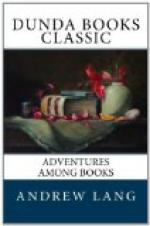Dr. John Brown was born in Biggar, one of the gray, slaty-looking little towns in the pastoral moorlands of southern Scotland. These towns have no great beauty that they should be admired by strangers, but the natives, as Scott said to Washington Irving, are attached to their “gray hills,” and to the Tweed, so beautiful where man’s greed does not pollute it, that the Border people are all in love with it, as Tyro, in Homer, loved the divine Enipeus. We hold it “far the fairest of the floods that run upon the earth.” How dear the border scenery was to Dr. John Brown, and how well he knew and could express its legendary magic, its charm woven of countless ancient spells, the music of old ballads, the sorcery of old stories, may be understood by readers of his essay on “Minchmoor.” {3} The father of Dr. Brown was the third in a lineage of ministers of the sect called Seceders. To explain who the Seceders were, it would be necessary to explore the sinking morasses of Scotch ecclesiastical history. The minister was proud of being not only a “Seceder” but a “Burgher.” He inherited, to be brief, the traditions of a most spiritually-minded and most spirited set of men, too much bent, it may appear to us, on establishing delicate distinctions of opinions, but certainly most true to themselves and to their own ideals of liberty and of faith. Dr. Brown’s great-grandfather had been a shepherd boy, who taught himself Greek that he might read the New Testament; who walked twenty-four miles—leaving his folded sheep in the night—to buy the precious volume in St. Andrews, and who, finally, became a teacher of much repute among his own people. Of Dr. Brown’s father, he himself wrote a most touching and beautiful account in his “Letter to John Cairns, D.D.” This essay contains, perhaps, the very finest passages that the author ever penned. His sayings about his own childhood remind one of the manner of Lamb, without that curious fantastic touch which is of the essence of Lamb’s style. The following lines, for example, are a revelation of childish psychology, and probably may be applied, with almost as much truth, to the childhood of our race:—
“Children are long of seeing, or at least of looking at what is above them; they like the ground, and its flowers and stones, its ’red sodgers’ and lady-birds, and all its queer things; their world is about three feet high, and they are more often stooping than gazing up. I know I was past ten before I saw, or cared to see, the ceilings of the rooms in the manse at Biggar.”
I have often thought that the earliest fathers of our race, child-like in so many ways, were child-like in this, and worshipped, not the phenomena of the heavens, but objects more on a level with their eyes—the “queer things” of their low-lying world. In this essay on his father, Dr. Brown has written lines about a child’s first knowledge of death, which seem as noteworthy as Steele’s famous passage about his father’s death and his own half-conscious grief and anger. Dr. Brown describes a Scottish funeral—the funeral of his own mother—as he saw it with the eyes of a boy of five years old, while his younger brother, a baby of a few months—




